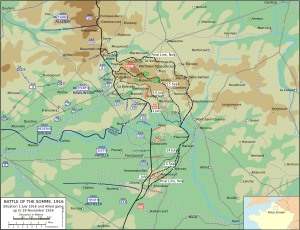Delville Wood order of battle facts for kids
Quick facts for kids Battle of Delville Wood |
|||||||
|---|---|---|---|---|---|---|---|
| Part of the Battle of the Somme in the First World War | |||||||
 |
|||||||
|
|||||||
| Belligerents | |||||||
| Commanders and leaders | |||||||
| Strength | |||||||
| 9 divisions, 1 brigade | |||||||
| Only brigades and battalions that participated in the actions associated with the Battle of Delville Wood are shown. For details on the full organisation, see the Order of Battle for the Somme. | |||||||
The Battle of Delville Wood was a very tough fight during the First World War. It happened from 14 July to 3 September 1916. This battle was part of the larger Battle of the Somme in France. British and French soldiers fought against the German army in a place called Delville Wood.
This battle was especially important for the 1st South African Brigade. It was their first big fight on the Western Front. They bravely captured Delville Wood and held it from 15 to 19 July. The South African soldiers faced huge losses, similar to many other British brigades on the first day of the Somme battle.
Even after the South Africans were relieved, the fighting for the wood continued. It lasted until the end of August. British forces finally took control of the last German positions on 27 August. However, the Germans launched a big counter-attack on 31 August. They managed to get back part of the wood's northern edge. British attacks from 4 to 8 September then secured the wood. It remained under Allied control until battles in 1918.
Contents
What was Delville Wood?
Delville Wood is a forest area in northern France. During the First World War, it became a key battleground. Soldiers fought fiercely to control this wooded area. Today, Delville Wood is a preserved site. You can still see the remains of trenches there. There is also a museum and a monument. These honor the brave soldiers of the 1st South African Brigade.
The Battle Begins: July 1916
The Battle of Delville Wood started on 14 July 1916. The main goal was to capture this important wooded area. The 9th (Scottish) Division, which included the 1st South African Brigade, led the attack.
The South African soldiers faced very strong German defenses. They fought their way into the wood. It was a brutal fight, tree by tree. They managed to capture the wood on 15 July. Holding it was even harder. The Germans launched many counter-attacks. They wanted to take the wood back.
For five days, from 15 to 19 July, the South African Brigade held their ground. They were surrounded and constantly attacked. They showed incredible courage and determination. They faced heavy artillery fire and close-quarters combat.
Holding the Wood: A Tough Fight
After the South African Brigade was relieved, other British divisions continued the fight. The wood was a very difficult place to fight. It was full of shattered trees and deep craters. This made it hard to move and see the enemy.
Many different British divisions took turns fighting in Delville Wood. These included the 2nd Division, 3rd Division, 17th (Northern) Division, 20th (Light) Division, and 24th Division. Each unit faced intense German resistance. The fighting was often hand-to-hand.
The battle for the wood dragged on for weeks. German forces kept trying to push the British out. The British kept fighting to hold their gains. It was a constant struggle for control. The wood changed hands multiple times.
The Cost of Battle
The Battle of Delville Wood was one of the bloodiest fights of the Somme. The soldiers who fought there suffered terrible losses. The 1st South African Brigade was almost completely wiped out.
When they entered the battle on 14 July, the South African Brigade had 123 officers and 3,032 other ranks. By 20 July, after holding the wood for five days, their numbers were drastically reduced. They had lost 104 officers and 2,432 other ranks. This means that out of 3,155 soldiers, only 619 were still able to fight. This shows the extreme danger and sacrifice of the battle.
Many other British and German units also suffered huge casualties. Delville Wood became known as a place of immense sacrifice. It reminds us of the terrible human cost of war.
Images for kids


